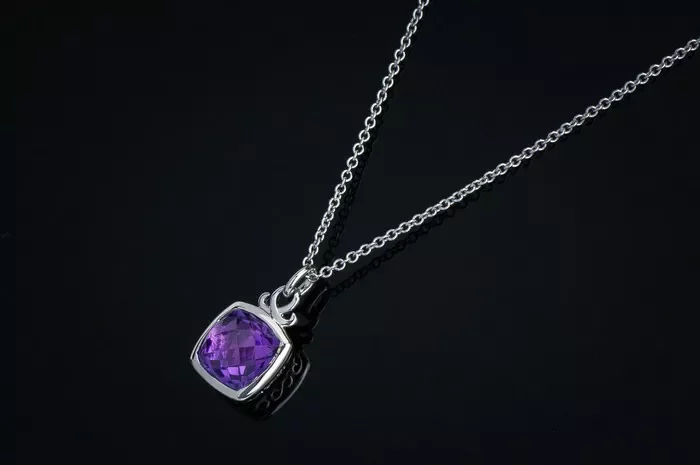Jewelry, as an integral part of human culture, has been a symbol of beauty, power, and status for thousands of years. Among the various types of jewelry, necklaces occupy a special position due to their ability to accentuate one’s neckline and overall appearance. Today, we will delve into the world of amethyst necklaces, exploring their characteristics, usage, maintenance, and cultural significance.
Understanding Amethyst
Amethyst is a variety of quartz that exhibits a beautiful violet or purple hue. This striking color is caused by trace amounts of iron and aluminum impurities within the quartz crystals. The name “amethyst” originates from the Greek word “amethystos,” meaning “not drunken,” as ancient Greeks believed amethyst could prevent intoxication. This belief added a layer of mystical allure to the gemstone, making it a favorite among royalty and aristocracy.
Characteristics of Amethyst Necklaces
Color and Clarity: The most striking feature of an amethyst necklace is its vibrant purple color. The intensity of the purple can range from light lavender to deep, almost royal purple. Clarity refers to the internal flaws or inclusions within the gemstone. While some inclusions may be visible, they often add to the uniqueness and charm of each piece.
Cut and Shape: Amethyst gemstones can be cut into various shapes and sizes, such as rounds, ovals, cushions, and more. The cut of the gemstone significantly impacts its brilliance and ability to reflect light. A well-cut amethyst will display a beautiful play of colors and light.
Metal Settings: Amethyst gemstones are often set in metals such as sterling silver, gold, or platinum. The choice of metal not only affects the durability of the necklace but also its overall aesthetic. Sterling silver, for example, offers a classic and elegant look, while gold can add a touch of luxury and warmth.
How to Wear an Amethyst Necklace
Choosing the Right Occasion: An amethyst necklace is versatile enough to be worn on various occasions, from everyday wear to formal events. For casual settings, choose a simpler design with a smaller gemstone. For more formal occasions, opt for a more intricate design with larger, more vibrant gemstones.
Matching with Outfits: The color of amethyst complements many different colors and styles of clothing. For instance, it pairs beautifully with warm tones like browns and oranges, creating a cozy and inviting look. It also contrasts well with cooler tones like blues and greens, adding a pop of color to your outfit.
Layering: Layering necklaces is a popular trend that allows you to mix and match different styles and lengths. An amethyst necklace can be layered with other gemstone necklaces or simple chain necklaces to create a layered, bohemian look.
Maintaining an Amethyst Necklace
Cleaning: Regular cleaning is essential to maintain the brilliance and longevity of your amethyst necklace. Use a soft cloth and warm water to gently wipe away any dirt or debris. Avoid using harsh chemicals or abrasive materials, which could scratch or damage the gemstone.
Storage: When not wearing your amethyst necklace, store it in a soft cloth or jewelry box to prevent scratches and damage. Avoid exposing it to extreme temperatures or direct sunlight, which could fade its color over time.
Inspection: Regularly inspect your amethyst necklace for any signs of wear or damage. If you notice any loose prongs or scratches, take it to a jeweler for professional repair.
Cultural Significance and Symbolism
Spiritual Healing: In many cultures, amethyst is believed to have spiritual and healing properties. It is thought to promote calmness, clarity, and peace, making it a popular choice for meditation and spiritual practices.
Protection and Strength: Historically, amethyst was believed to protect its wearer from negative energy and provide strength during times of stress or adversity. This made it a favorite among warriors and travelers.
Love and Relationships: The color purple is often associated with love and relationships. An amethyst necklace can be a thoughtful gift for a loved one, symbolizing your deep connection and commitment.
Popular Science Behind the Beauty of Amethyst
The beauty of amethyst lies not only in its striking appearance but also in its unique physical properties. As a variety of quartz, amethyst is composed of silicon dioxide crystals. The violet and purple hues are caused by the presence of trace elements such as iron and aluminum, which absorb certain wavelengths of light and reflect others.
Quartz crystals are known for their piezoelectric properties, meaning they can generate an electrical charge when subjected to pressure. This property is believed to contribute to the healing and calming effects of amethyst, as it can interact with the body’s bioelectric field.
Conclusion
In conclusion, an amethyst necklace is a beautiful and meaningful piece of jewelry that combines natural beauty with cultural significance. Whether worn for its aesthetic appeal or its spiritual properties, an amethyst necklace can enhance your appearance and provide a sense of calm and clarity. With proper care and maintenance, your amethyst necklace will remain a cherished possession for years to come.
Related topic:
- How to Charge an Amethyst Necklace?
- How to Tell if an Amethyst Necklace is Real
- How to Obtain the Braxton Amethyst Necklace


